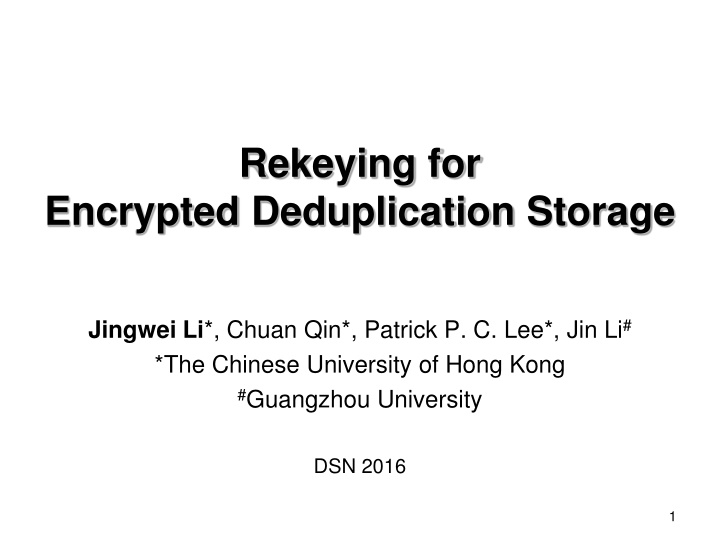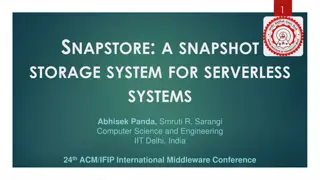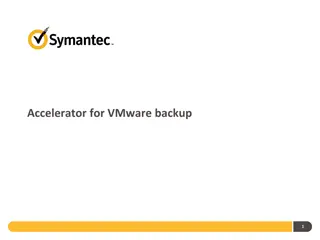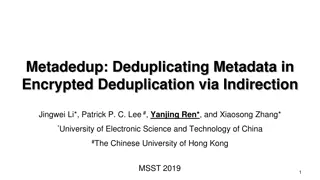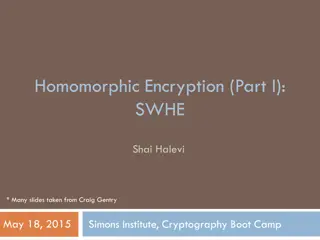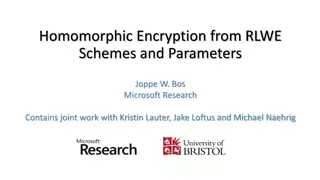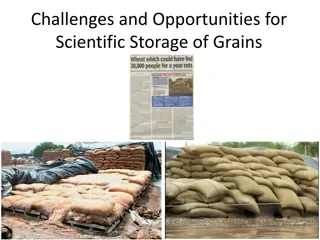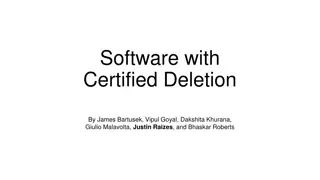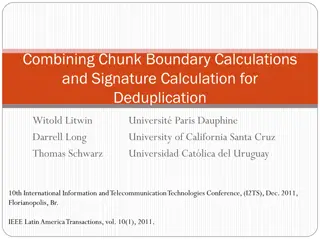Efficient Rekeying for Encrypted Deduplication Storage
Cloud storage outsourcing is common today, presenting challenges like security and storage efficiency. Encryption and deduplication play crucial roles in addressing these challenges. However, traditional encryption methods inhibit deduplication. Rekeying offers a solution by renewing security protection without compromising data access. Our contributions include designing REED, a Rekeying-aware Encrypted Deduplication storage system that provides secure and lightweight rekeying while preserving content similarity for deduplication.
Download Presentation

Please find below an Image/Link to download the presentation.
The content on the website is provided AS IS for your information and personal use only. It may not be sold, licensed, or shared on other websites without obtaining consent from the author.If you encounter any issues during the download, it is possible that the publisher has removed the file from their server.
You are allowed to download the files provided on this website for personal or commercial use, subject to the condition that they are used lawfully. All files are the property of their respective owners.
The content on the website is provided AS IS for your information and personal use only. It may not be sold, licensed, or shared on other websites without obtaining consent from the author.
E N D
Presentation Transcript
Rekeying for Encrypted Deduplication Storage Jingwei Li*, Chuan Qin*, Patrick P. C. Lee*, Jin Li# *The Chinese University of Hong Kong #Guangzhou University DSN 2016 1
Cloud Storage Outsourcing data management to public cloud storage is common today Challenges: Security in outsourced storage Storage efficiency Solutions: Encryption: encrypts data before outsourcing Deduplication: stores one message for redundant messages with same content Compression can be further applied 2
Encryption vs. Deduplication K Message M1 C Can t be dedup ed Can be dedup ed K Message M2 C Traditional encryption prohibits deduplication Same messages encrypted with different keys different ciphers 3
Encrypted Deduplication Message-locked encryption [Bellare, EUROCRYPT 13] Derive encryption key from message itself Same message Identical cipher text e.g., convergent encryption: key = message hash DupLESS[Bellare, USENIX Security 13] Realizes message-locked encryption A dedicated key manager for key generation MLE key generated by a derivation function Same messages same ciphers Ciphers appear random 4
Rekeying Rekeying renews security protection Replaces an existing key with a new encryption key Benefits: Protects against key compromise Revokes unauthorized users from accessing data Challenges: Renewing derivation function makes new data fail to be dedup ed with old data Cipher re-encryption is expensive 5
Rekeying Challenges Renewing derivation function (e.g., K K ): new data can t be dedup ed with old data: Message Message K K Old Cipher New Cipher Cipher re-encryption with new key K : Message K K Old Cipher New Cipher 6
Our Contributions Design REED, a Rekeying-aware Encrypted Deduplication storage system Provides secure and lightweight rekeying Preserves content similarity for deduplication Two encryption schemes for REED Basic: high performance (203MB/s) Enhanced: resilient against key leakage (155MB/s) Enabling dynamic access control Testbed experiments 7
Threat Model Honest-but-curious adversary, who can: Compromise storage backend Collude with any revoked client Attempt to learn files beyond access scope Monitor keys returned by key manager Assumptions: Encrypted and authenticated communication between client and key manager (e.g., by SSL/TLS) Key manager cannot infer message content (OPRF) Key manager is deployed in protected zone 8
Main Idea Build security on two symmetric keys: File key: renewable, controlling access for files MLE key: unchanged, preserving deduplication Extends convergent all-or-nothing transform (CAONT) [Li, USENIX ATC 15] Encrypts entire message using MLE key; and further encrypts a small part (stub) using file key Performs deduplication on large part; yet message is unrecoverable with any small part unavailable Rekeying on stub (64 bytes, 0.78% for 8KB chunks) 9
REED Overview Client Cloud File Chunk Storage Backend Server File Chunk Client Key Manager Target workload: backup and archival storage 10
[Li, USENIX ATC15] CAONT Hash Key Chunk h XOR t CAONT Package G H M M XOR C Limitation: Secure for unpredictable messages only (otherwise, vulnerable to brute-force dictionary attacks) 11
Basic Encryption MLE Key Chunk KM XOR t Stub G H M M Trimmed Package XOR C Fix value canary c Two modifications to CAONT Replaces hash key by MLE key from key manager Add a canary for integrity checking Limitation: vulnerable to MLE key compromise 12
Enhanced Encryption MLE Key Chunk KM h XOR KM KM t Stub Self- XOR G M M E C1 Trimmed Package C1 XOR C2 MLE CAONT Resilient against MLE key leakage: First applies MLE to form a ciphertext Then applies CAONT to the MLE ciphertext Rationale: MLE ciphertext is further protected by CAONT 13
Comparison Basic encryption: Vulnerable to MLE key compromise Adversary can recover large part (trimmed package) of the original message with MLE key obtained Faster encryption Enhanced encryption: Higher security level Adversary needs both MLE key and file key to recover a message Even if MLE key is disclosed, remains secure for unpredictable messages Slower encryption 14
Dynamic Access Control MLE Key REED Client File encryption File key File decryption H CP-ABE enc. Key state REED Server CP-ABE dec. Key regression Private Derivation Key Private Access Key Uses CP-ABE for access control [Bethencourt, S&P 07] Uses key regressionfor lazy revocation [Kamara, NDSS 06] 15
Dynamic Access Control Lazy revocation Current key state can derive previous states Revoked user cannot access future key states Allows user to access not-yet-updated files Defers file re-encryption (e.g. midnight update) Active revocation Re-encryption happens immediately with new key 16
Confidentiality Level 1: same as DupLESS Adversary can access all trimmed packages, encrypted stubs, and encrypted key states Level 2: colluding with revoked users Adversary can learn a set of private access keys from any revoked user Level 3: monitoring key generation Adversary can monitor a subset of revoked users and identify MLE keys returned by key manager 17
Integrity Basic encryption By checking the canary attached to recovered chunks Enhanced encryption By comparing the hash of MLE ciphertext 18
Implementation Entities: Client: chunking, encryption/decryption, upload/download Key manager: MLE key generation Server: deduplication, metadata storage Cloud:file recipe, stub, key states Optimization: Batch key generation requests to mitigate I/O Cache previous MLE keys to reduce computation Parallelize key generation, encryption and upload via multi-threading 19
Evaluation Datasets Synthetic dataset (2 GB files with unique chunks) FSL data trace (147 daily snapshots, 56.2 TB in total) Testbed Servers connected over a Gigabit LAN 20
MLE Key Generation Key generation is expensive (for unique data) REED achieves 17.64 MB/s 21
Encryption Encryption is not a bottleneck Basic: 203MB/s Enhanced:155MB/s 22
Data Transfer Caching boosts overall performance First upload bounded by key generation (17MB/s) Second upload of identical data bounded by network (106MB/s) 23
Rekeying Performance Rekeying delays remain small 3.4s for 8 GB data 24
Storage Efficiency Storage overhead of FSL traces Storage saving of 98.6% Reduces storage space for ~56 TB logical data to ~431 GB physical data plus ~380 GB stub data 25
Trace-driven Upload/Download 7 consecutive daily backups First day around 13.1 MB/s due to key generation Later transfers reach around 105 MB/s 26
Conclusions REED: Enables rekeying for encrypted deduplication storage Proposes two encryption schemes Enables dynamic access control Implements a prototype Conducts extensive trace-driven evaluation Software: http://ansrlab.cse.cuhk.edu.hk/software/reed 27
